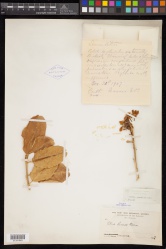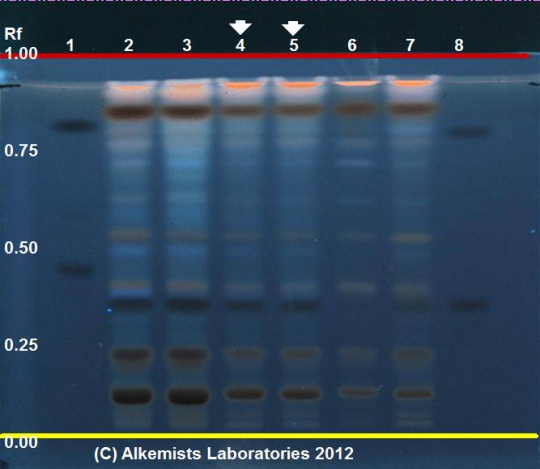Citrus paradisi (seed)
Contents |
Nomenclature
Citrus x paradisi Macfad. Rutaceae
Standardized common name (English): grapefruit
Botanical Voucher Specimen
|
|
Organoleptic Characteristics
Macroscopic Characteristics
Microscopic Characteristics
High Performance Thin Layer Chromatographic Identification
|
Grapefruit (seed) (Citrus paradisi) Lane Assignments Lanes, from left to right (Track, Volume, Sample):
Reference materials used here have been authenticated by macroscopic, microscopic &/or TLC studies according to the reference source cited below held at Alkemists Laboratories, Costa Mesa, CA. Stationary Phase Silica gel 60, F254, 10 x 10 cm HPTLC plates Mobile Phase CHCl3: CH3OH: HCOOH: H2O [6/2/1.4/0.1] Sample Preparation Method 0.3 g + 3 ml CH3OH sonicate/heat @ 50° C ~ 1/2 hr Detection Method 10% Ethanolic H2SO4-> 115° C 15 min -> UV 365 nm Reference see Method Developed by Alkemists Laboratories
|
Supplementary Information
ABC Botanical Adulterants Prevention Program Laboratory Guidance
Grapefruit (seed extract) (Citrus paradisi)
General Characteristics This ABC BAPP Laboratory Guidance Document presents an overview and comparison of various analytical technologies and methods used to differentiate between authentic grapefruit seed extract ingredients and non-authentic materials, with particular discussion of synthetic microbicidal compounds identified in non-authentic materials, authentic grapefruit seed extract components, and a detailed literature review of methods (including sample characterization via TLC, HPLC-UV, HPLC-MS, GC-MS, and others).
Source: ABC, Botanical Adulterants Prevention Program [3]
Sources
- ↑ Images courtesy of the C.V. Starr Virtual Herbarium of the New York Botanical Garden http://sciweb.nybg.org/science2/VirtualHerbarium.asp
- ↑ Elan M. Sudberg, Alkemist Laboratories http://www.alkemist.com
- ↑ ABC, Botanical Adulterants Prevention Program http://cms.herbalgram.org/BAP/LGD/GrapefruitSeedExtractLabGuidanceDocument.html



